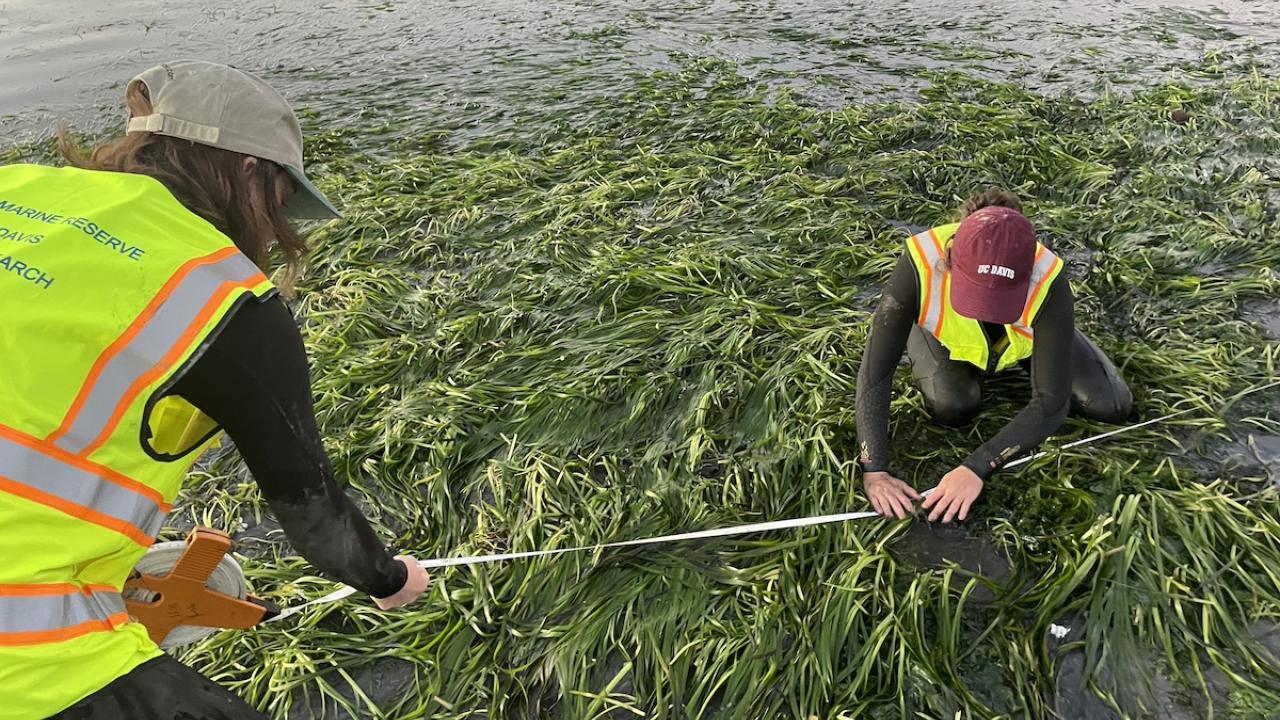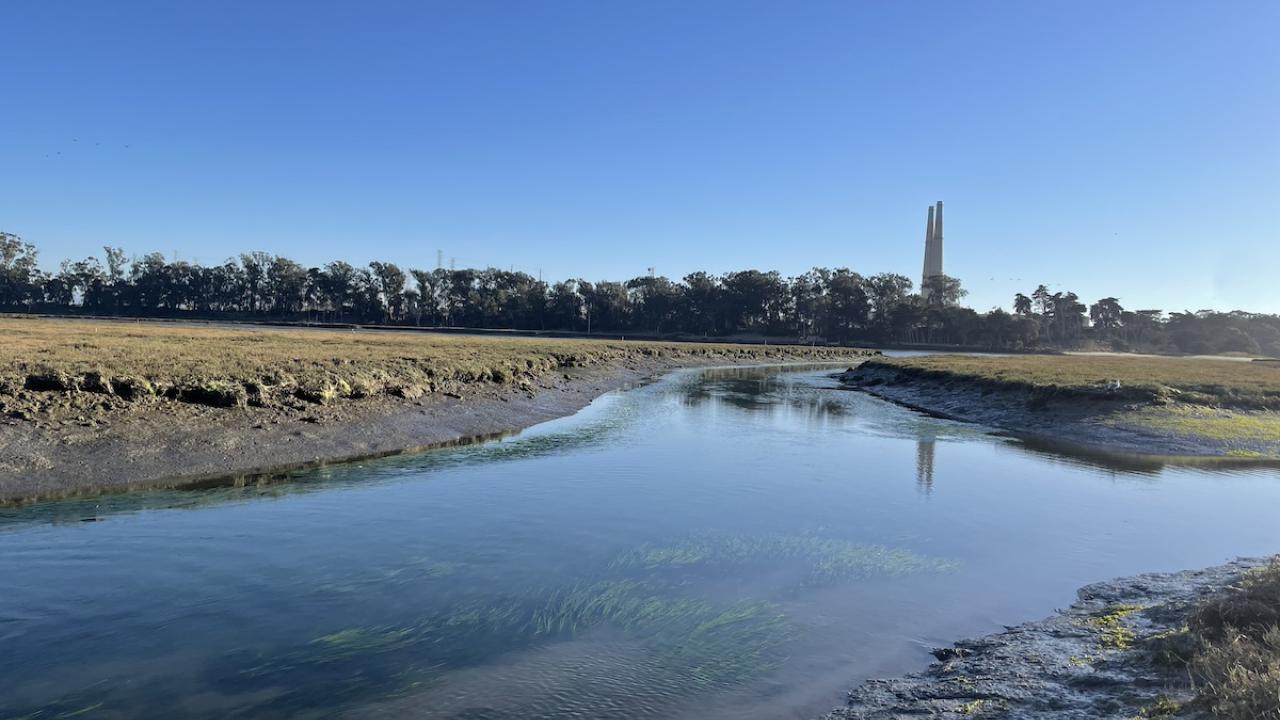
In the Seagrass Meadows
A Day in the Field with UC Davis Researchers
Invisible in the clear afternoon sky, the moon tugged the tidal channel’s brackish waters towards the Pacific Ocean. It drew them out slowly, languidly, the water’s surface eddying and rippling in the sunlight.
Elisabeth Sellinger stood shoulder-deep in the withdrawing water. She sifted through the mudflats with a measuring rod, searching for a small plastic plate buried in the sediment during a previous field season. The bark of sea lions and cries of coastal birds provided a soundtrack as Mazie Lewis waited nearby on the shoreline, a clipboard and mechanical pencil in hand.
“The process is very meditative,” said Lewis, a junior specialist with the Ocean Climate Lab Group. “You have to let go of any expectations.”

Suddenly, Sellinger gasped. Lewis matched the joyous outburst. They’d struck the sought-after plate.
“I feel like I’m playing Battleship every time I come out here,” said Sellinger, an earth and planetary sciences Ph.D. student working with the Ocean Climate Lab Group. “Once I hit the plate, I never know where the rest of it is going to be. I think it’s going to be here or here, but it’s actually over there. And these plates are only three inches across, so I just keep missing. Hit or miss. Miss. Miss.”
Sellinger measured the plate three times and called out numbers correlating to depth while Lewis took notes.
“What we’re looking for is whether the sediment is accumulating or eroding through time and this is in relation to the distance of the plates to seagrass meadows,” Sellinger said. “The plates could be in meadows, not near them at all or somewhat near to them.”
As Elkhorn Slough emptied its waters into the ocean, patches of thick seagrass emerged from the turbid depths, their blades a striking green against the clay-gray mudflats.
A nursery habitat for many marine animals, including mammals, shellfish and fish, seagrass meadows are vital ecosystems. But their benefits don’t just touch the ocean-dwellers of our planet.
UC Davis research has revealed that seagrass beds improve water chemistry, reducing local water acidity by up to 30%. They also naturally absorb carbon, storing the element in the sediments beneath them at a rate nearly three times higher than terrestrial forests. All signs point to these habitats being an important buffer against the effects of ocean acidification.
“Seagrasses are not the be-all and end-all solution to everything,” said Sellinger, thinking about efforts to mitigate human-induced climate change. “They’re a piece of the puzzle and I think we need every piece in the puzzle.”

A unique field site
The mouth of Elkhorn Slough, where it meets the Pacific Ocean, occupies a unique place in time and space. While the nearby unincorporated community of Moss Landing only has a population of 237, humanity’s imprint is visible on the surrounding landscape. From the slough’s waters, you can see the two stacks of the nearby Moss Landing Power Plant. Cars putter along Highway 1, which crosses over the entrance of the slough. Across the road is a busy boat dock.
“The juxtaposition is really striking,” Sellinger said. “You think of the marine reserve, this pristine environment, and then you see all this human interaction right next to it. It’s kind of surprising, but it’s also inspiring.”
It’s inspiring because the seagrass ecosystem persists, resilient in the face of potential obstacles.
Sellinger’s and Lewis’ research in the area is a continuation of preliminary work conducted in the area by Melissa Ward, a UC Davis alum and adjunct faculty member at San Diego State University, and Kathryn Beheshti, an assistant researcher at the UC Santa Barbara Marine Science Institute.
“Melissa was mostly looking at carbon stocks, so how much carbon is stored in the systems and comparing different sites along California’s coast,” Sellinger said. “We don’t have much data at all about how much carbon is stored in seagrass sediments in California.”
Beheshti was actively restoring seagrass meadows in the area, planting patches and measuring how they improved ecosystem services and functions over time. “We’re looking specifically at carbon storage to follow up on that,” Sellinger said.

Trudging through the muck
The sun slipped across the sky as the hours passed. By early evening, Sellinger and Lewis, who wore bright yellow reflective safety vests over their wetsuits, were crossing Highway 1’s bridge on their way to Beheshti’s field site. They navigated an embankment and jumped into the wet sand. They trudged through the mudflats, a sopping sound accompanying their footsteps.
Here, the seagrass meadows were completely exposed thanks to the low tide. The thick beds hugged the shoreline.
Sellinger and Lewis spent the next hour of daylight burying stainless steel plates for their sediment analysis project. They planted stakes where the plates were buried, a marker for their future selves. A curious sea lion supervised the work for the duration, poking its head above the water every so often to eye the researchers.
“In relation to marine animals, seagrasses are super important because they act like a nursery habitat for a lot of marine species and provide protection from wave action,” Sellinger said. “That’s why they’re a really good space for raising young and smaller species in general. There’s also a lot of food.”
For the next few years, Sellinger will continue to return to Elkhorn Slough in an effort to quantify the benefits of seagrass meadow restoration. How much carbon is stored in the beds beneath them? And how do restored meadows compare to native meadows?
As flying Vs of seabirds cut across the sherbert evening sky, a nearby disturbance in the water drew the research duo’s attention. In the shin-high water, a small, wing-like fin waved along the surface.
“A bat ray,” said Lewis, noting that the species frequents sloughs, a place where they birth their live young.
Lewis said she’d only seen bat rays in aquariums. This was her first time encountering one in the wild.

This article originally appeared in the Letters and Science Magazine.
